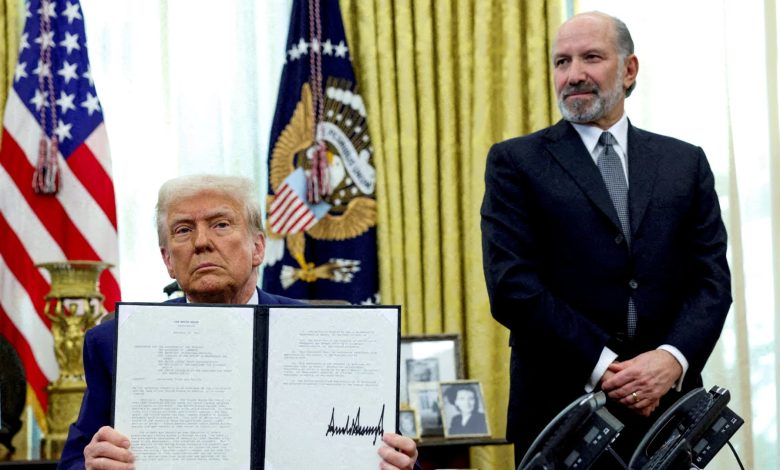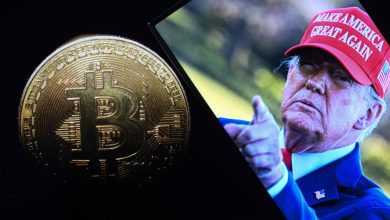Small tech firms left in limbo by shifting Trump tariff policy

President Donald Trump holds an executive order about tariffs increase, flanked by U.S. Commerce Secretary Howard Lutnick, in the Oval Office of the White House in Washington, D.C., U.S., February 13, 2025.
Kevin Lamarque | Reuters
When President Donald Trump made it clear that he was serious about implementing dramatic tariffs on top U.S. trading partners, Robin Liss knew her Suvie machines were in trouble.
Suvie’s products — kitchen gadgets that can whip up dinner in a matter of minutes — are built in a facility in one of China’s largest manufacturing hubs and are comprised of more than 500 components sourced throughout the country.
After running the financial models and tallying the costs associated with the new levies, Liss set off to Asia in March to search for an alternative business plan.
“I’m going to run out of appliances,” Liss said, ahead of her two-week trip to Taiwan and Vietnam. “I’ve got to figure this out.”
Suvie is among the scores of gadget makers scrambling to stay afloat while managing through President Trump’s tariff plans and the uncertainty that they bring. The day-to-day changes in rhetoric from the White House has created volatility on Wall Street, where tech stocks just wrapped up their worst quarter since 2022, and a sense of panic for smaller businesses that have less of a cushion to deal with the added costs of operations and potential supply chain bottlenecks.
Trump slapped additional tariffs on China earlier this year and is now going much bigger, threatening to strain America’s relationships with other longtime trading partners. On Wednesday afternoon, President Trump is expected to deliver remarks at a “Make America Wealthy Again Event” in the Rose Garden, and to announce reciprocal tariffs that follow a bevy of other import duties on goods from China, Canada and Mexico. Those three countries accounted for over $1.3 trillion, or about 40%, of total imports last year, according to the U.S. Census Bureau.
“Folks who thought they had safely moved their supply chain out of China suddenly find themselves wondering if that was a great decision,” said Peter Hanbury, a partner at consulting firm Bain. “There’s a lot of different options about where you could move things, but you don’t want to make that decision if you don’t know exactly where the tariff structure is going to land.”
Suvie’s cooking appliance
Suvie
Liss said her company, based in Cambridge, Massachusetts, is eating the costs — for now — rather than passing them on to customers. For Suvie, those costs aren’t just tied to its appliances, which are about the size of a microwave but offer more than 10 different cooking modes.
She also has to deal with higher food prices, as part of Suvie’s business is selling meal kits starting at $11.49. Suvie delivers meals to customers weekly, but also has plans for users who prefer deliveries every two to four weeks.
Consumer losing buyer power
The problem for Suvie and other consumer-focused businesses is that just as their costs are skyrocketing due to tariffs and other inflationary pressures, Americans are losing their buying power.
A recent analysis from the Yale Budget Lab estimates that tariffs could cost the average American household an additional $1,600 to $2,000 a year. Target CEO Brian Cornell told CNBC in March that consumers could see imminent price increases on produce items such as strawberries and avocados.
Liss launched Suvie in 2015 and began shipping products in 2019, a year after a Kickstarter campaign for a “kitchen robot with multi-zone cooking and refrigeration.” The company has 20 U.S. employees and has avoided layoffs thus far, thanks to 80% growth last year that Liss said brought annual revenue to between $20 million and $30 million.
If not for recent China tariffs, which hiked the levies she pays on goods to 23% from 3%, Liss said Suvie would be operating at a profit.
Liss said that no matter what Trump announces on Wednesday, in what he’s calling “Liberation Day,” the existing tariffs on goods from China have made it imperative that she find a new country for production. But where the company lands depends on what gets thrown into the mix.
Wherever Suvie goes, the company estimates it can scale up within six months.
“That is incredibly fast and almost unheard of,” Liss said. “But if we don’t pull it off, we might not have products for the holidays, which is our main sales season.”
For Austere founder Deena Ghazarian, tariffs on products from China as well as Mexico have put her business in peril.
Austere, based in Wilsonville, Oregon, south of Portland, makes cable, cleaning, and surge-protected power products. The 12-person company, founded in 2018, previously moved about half of its operations to Taiwan and Vietnam from China and was in talks to shift production to Mexico. Those discussions stalled in November.
Depending on the item, up to 50% of Ghazarian’s components come from China. Half of her products are still made there, while the rest are manufactured in Taiwan and Vietnam. For her cleaning product solution, which is the most reliant on China, she estimates it would take over a year to move production to Thailand.
Ghazarian began stockpiling products last year for the company to get ahead of potential tariffs. She says others have done the same. The inventory investment has diverted many resources she’d otherwise use for hiring, marketing and scaling.
“I’m buying time to figure out my next move,” she said. “If I keep having to spend this money to shift to get around it – at some point it’s not going to have a return that’s worth it financially.”
The final step would be hiking prices for consumers, which Ghazarian said many partners she works with are already planning to implement later this week.
‘Just devastating’
The whole electronic devices market is feeling the pain.
The Consumer Technology Association estimated in January that new tariffs could hike laptop and tablet prices by as much as 68%, and boost smartphone prices by as much as 37%. Video game consoles could rise as much as 58%. Tariffs would reduce consumer spending power by $90 billion to $143 billion annually, it estimates.
“This is just devastating to the U.S. economy,” said CTA CEO Gary Shapiro. “It’s tremendously inflationary.”
Andrew Wilson, deputy secretary general and global head of policy at the International Chamber of Commerce, said that the cost implications from a 20% to 25% tariff could be severe enough to wipe out a company’s entire operating margin, while also complicating it ability to operate abroad.
“There is a risk if retaliation takes hold in the global economy, that we see a severe worsening of the business environment for the tech sector, and for American firms,” he said.
The logistics of moving are unrealistic for many companies. Over the years, Chinese cities such Shenzhen, Guangzhou and Dongguan have established themselves as key manufacturing meccas for technology and electronics production.
Workers process data cables at a workshop of an electronics company in the economic development zone of Anlong County, Qianxinan Buyi and Miao Autonomous Prefecture, in Qianxinan, China, on March 12, 2025.
Costfoto | Nurphoto | Getty Images
Those markets have steadily accrued the best component supply base, labor expertise and cost structures, which are difficult to replicate elsewhere, said Terry Arbaugh, chief commercial officer at SEACOMP, which designs and manufactures electronics such as thermostats and video game devices for customers. The company operates facilities in China and Mexico.
“Talk of tariffs is sending more business outside of China, but in a lot of cases, it’s also not coming into the U.S.,” Arbaugh said.
Many larger corporations have managed to pivot production to areas like Taiwan, Thailand and India over the years, but have also exhausted much of the existing supply in those smaller markets, Arbaugh said. And making lower cost consumer and medical electronics in volume in the U.S. is not a viable option for many businesses, he added.
Suvie isn’t considering onshoring its production at the moment, and is currently focused on finding an alternative spot in Asia.
Liss has already booked a flight back to Taiwan in a couple weeks. From there, she’ll hop around to other countries in the region for more answers.
“Maybe I’ll book the next flight in the air,” she said from the Detroit airport on the way home from her initial Asia trek.
WATCH: Economists estimate how much revenue tariffs could bring in



